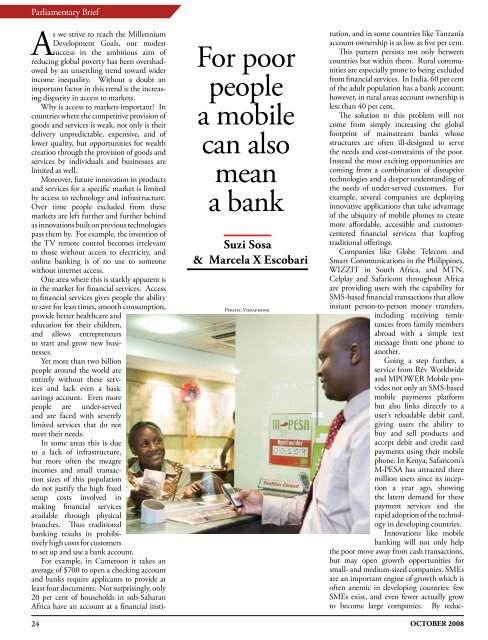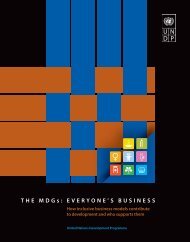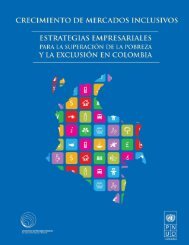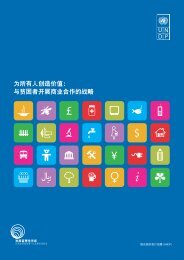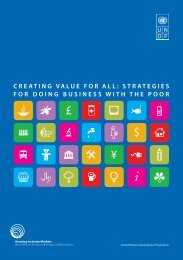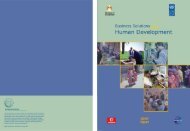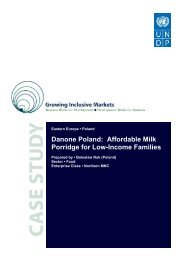Parliamentary Brief24For poorpeoplea mobilecan alsomeana bankSuzi Sosa& Marcela X EscobariPho<strong>to</strong>: VodaphoneAs we strive <strong>to</strong> reach <strong>the</strong> MillenniumDevelopment Goals, our modestsuccess in <strong>the</strong> ambitious aim ofreducing global poverty has been overshadowedby an unsettling trend <strong>to</strong>ward widerincome inequality. Without a doubt animportant fac<strong>to</strong>r in this trend is <strong>the</strong> increasingdisparity in access <strong>to</strong> markets.Why is access <strong>to</strong> markets important? Incountries where <strong>the</strong> competitive provision ofgoods and services is weak, not only is <strong>the</strong>irdelivery unpredictable, expensive, and oflower quality, but opportunities for wealthcreation through <strong>the</strong> provision of goods andservices by individuals and <strong>business</strong>es arelimited as well.Moreover, future innovation in productsand services for a specific market is limitedby access <strong>to</strong> technology and infrastructure.Over time people excluded from <strong>the</strong>semarkets are left fur<strong>the</strong>r and fur<strong>the</strong>r behindas innovations built on previous technologiespass <strong>the</strong>m by. For example, <strong>the</strong> invention of<strong>the</strong> TV remote control becomes irrelevant<strong>to</strong> those without access <strong>to</strong> electricity, andonline banking is of no use <strong>to</strong> someonewithout internet access.One area where this is starkly apparent isin <strong>the</strong> market for financial services. Access<strong>to</strong> financial services gives people <strong>the</strong> ability<strong>to</strong> save for lean times, smooth consumption,provide better healthcare andeducation for <strong>the</strong>ir children,and allows entrepreneurs<strong>to</strong> start and grow new <strong>business</strong>es.Yet more than two billionpeople around <strong>the</strong> world areentirely without <strong>the</strong>se servicesand lack even a basicsavings account. Even morepeople are under-servedand are faced with severelylimited services that do notmeet <strong>the</strong>ir <strong>needs</strong>.In some areas this is due<strong>to</strong> a lack of infrastructure,but more often <strong>the</strong> meagreincomes and small transactionsizes of this populationdo not justify <strong>the</strong> high fixedsetup costs involved inmaking financial servicesavailable through physicalbranches. Thus traditionalbanking results in prohibitivelyhigh costs for cus<strong>to</strong>mers<strong>to</strong> set up and use a bank account.For example, in Cameroon it takes anaverage of $700 <strong>to</strong> open a checking accountand banks require applicants <strong>to</strong> provide atleast four documents. Not surprisingly, only20 per cent of households in sub-SaharanAfrica have an account at a financial institution,and in some countries like Tanzaniaaccount ownership is as low as five per cent.This pattern persists not only betweencountries but within <strong>the</strong>m. Rural communitiesare especially prone <strong>to</strong> being excludedfrom financial services. In India, 60 per cen<strong>to</strong>f <strong>the</strong> adult population has a bank account;however, in rural areas account ownership isless than 40 per cent.The solution <strong>to</strong> this problem will notcome from simply increasing <strong>the</strong> globalfootprint of mainstream banks whosestructures are often ill-designed <strong>to</strong> serve<strong>the</strong> <strong>needs</strong> and cost-constraints of <strong>the</strong> poor.Instead <strong>the</strong> most exciting opportunities arecoming from a combination of disruptivetechnologies and a deeper understanding of<strong>the</strong> <strong>needs</strong> of under-served cus<strong>to</strong>mers. Forexample, several companies are deployinginnovative applications that take advantageof <strong>the</strong> ubiquity of mobile phones <strong>to</strong> createmore affordable, accessible and cus<strong>to</strong>mercenteredfinancial services that leapfrogtraditional offerings.Companies like Globe Telecom andSmart Communications in <strong>the</strong> Philippines,WIZZIT in South Africa, and MTN,Celplay and Safaricom throughout Africaare providing users with <strong>the</strong> capability forSMS-based financial transactions that allowinstant person-<strong>to</strong>-person money transfers,including receiving remittancesfrom family membersabroad with a simple textmessage from one phone <strong>to</strong>ano<strong>the</strong>r.Going a step fur<strong>the</strong>r, aservice from Rêv Worldwideand MPOWER Mobile providesnot only an SMS-basedmobile payments platformbut also links directly <strong>to</strong> auser’s reloadable debit card,giving users <strong>the</strong> ability <strong>to</strong>buy and sell products andaccept debit and credit cardpayments using <strong>the</strong>ir mobilephone. In Kenya, Safaricom’sM-PESA has attracted threemillion users since its inceptiona year ago, showing<strong>the</strong> latent demand for <strong>the</strong>sepayment services and <strong>the</strong>rapid adoption of <strong>the</strong> technologyin developing countries.Innovations like mobilebanking will not only help<strong>the</strong> poor move away from cash transactions,but may open growth opportunities forsmall- and medium-sized companies. SMEsare an important engine of growth which isoften anemic in developing countries: fewSMEs exist, and even fewer actually grow<strong>to</strong> become large companies. By reduc-OCTOBER 2008
Parliamentary Briefing <strong>the</strong> obstacles that stand in <strong>the</strong>ir way,innovations like mobile payments increase<strong>the</strong> ease of doing <strong>business</strong> with companies,and <strong>the</strong>reby increase companies’ chances atsuccess.For example, a Rêv Worldwide programmein partnership with a national paints<strong>to</strong>re chain in Mexico will allow painters<strong>to</strong> expand <strong>the</strong>ir cus<strong>to</strong>mer base, reduce <strong>the</strong>cost of doing <strong>business</strong>, and document <strong>the</strong>irtransaction his<strong>to</strong>ry <strong>to</strong> improve <strong>the</strong>ir access<strong>to</strong> credit. Painters will be able <strong>to</strong> acceptdebit and credit card payments from <strong>the</strong>ircus<strong>to</strong>mers using <strong>the</strong>ir cell phones, expanding<strong>the</strong>ir cus<strong>to</strong>mer base <strong>to</strong> those who prefer<strong>to</strong> use credit.Once <strong>the</strong> painter receives his paymentsfor <strong>the</strong> job, <strong>the</strong> money is loaded on<strong>to</strong> hisprepaid debit card that he can use for both<strong>business</strong> and personal purchases. Now <strong>the</strong>painter can request a documented cash flowstatement <strong>to</strong> be sent <strong>to</strong> a potential lenderand demonstrate his creditworthiness. Thepainter now is not only in a better position<strong>to</strong> make more money but is also betterable <strong>to</strong> leverage his income-stream <strong>to</strong> buildwealth.These innovations show a new andrefreshing wave of entrepreneurs who arenot only tapping in<strong>to</strong> a latent demandprofitably but tackling head on <strong>the</strong> self-reinforcingcycle of inequality. Governmentsand multilateral organisations have animportant role <strong>to</strong> play in stimulating thistype of private sec<strong>to</strong>r innovation.Certainly governments play a crucial rolein <strong>the</strong> prevention of money laundering andterrorist financing activities, all <strong>the</strong> whilemaintaining stability and averting financialcrises. However, in doing so <strong>the</strong>y ofteninadvertently hinder <strong>the</strong> expansion of financialservices <strong>to</strong> <strong>the</strong> poor.For example, transaction taxes can keeppeople from moving away from an informaland inefficient cash economy. One-sizefits-all‘know your cus<strong>to</strong>mer’ rules withantiquated identification requirementsmake it more difficult for virtual banking <strong>to</strong>develop. Unless countries start <strong>to</strong> examinehow <strong>the</strong>ir existing policies hinder this typeof entrepreneurship, <strong>the</strong>y will lose out on aneconomic revolution.Well-functioning markets are <strong>the</strong> fastestavenue for individual wealth creation andif this latent potential can be unlocked <strong>the</strong>Millennium Development Goals will bemore easily and quickly achieved.Suzi Sosa is <strong>the</strong> Chief of Staff ofMPOWER Labs Inc. Marcela X Escobariis <strong>the</strong> executive direc<strong>to</strong>r of <strong>the</strong> Centerfor International Development at HarvardUniversity.THE WORLD BUSINESS ANDDEVELOPMENT AWARDSTEN OFTHEBESTThere are ten winners of <strong>the</strong> 2008 WorldBusiness and Development Awards(WBDA) which showcase innovativeprivate sec<strong>to</strong>r initiatives contributing <strong>to</strong> <strong>the</strong>Millennium Development Goals (MDGs).Announced on 24 September <strong>the</strong> winningcompanies represent inspiring examples fromall over <strong>the</strong> globe, <strong>to</strong>ge<strong>the</strong>r improving <strong>the</strong> livesof over 75 million people.Established by <strong>the</strong> International Chamberof Commerce in 2000, and later joined by TheInternational Business Leaders Forum and <strong>the</strong>United Nations Development Programme,<strong>the</strong> WBDA recognise <strong>the</strong> contribution of <strong>the</strong>private sec<strong>to</strong>r <strong>to</strong> achieve <strong>the</strong> MDGs through<strong>the</strong>ir core <strong>business</strong>. The 2008 WBDA receivedan unprecedented 104 applications from 44countries.Four European companies, three African,two companies from Asia and one from SouthAmerica won awards in 2008.3K&A, a Ghanaian firm, developeda profitable soybean processing plant anddeveloped new soy products. It profited fromrapid growth in soybean production, madepossible through investment in farmingtechniques, commercial skills and planning.In consequence, 2,800 local farmers are nowearning over £530 per agricultural season.Nigeria is <strong>the</strong> second largest rice importerin <strong>the</strong> world. Olam Nigeria Limiteddecided <strong>to</strong> invest in local production of highquality rice for Nigeria’s domestic market. Inpartnership with USAID/Nigeria it developeda supply chain model that encouraged <strong>the</strong> useof improved technologies, farmer capacitybuilding and commercial linkages <strong>to</strong> marke<strong>to</strong>utlets, leading <strong>to</strong> on-farm productivityincreases of 260 per cent in 2006.M-PESA is <strong>the</strong> third African winner. Ithas brought mobile banking <strong>to</strong> millions ofKenyans, helping poorer communities buildincomes and work <strong>the</strong>ir way out of poverty.M-PESA is widely commented on in thismagazine (see pages 13-15, 24-25, and page26).Diageo joined a programme <strong>to</strong> develop<strong>the</strong> cultivation of a beer-friendly sorghum inNigeria and train farmers <strong>to</strong> grow <strong>the</strong> crop.Diageo breweries in Nigeria now source 95per cent of <strong>the</strong>ir grain from local farms andsustain around 27,000 jobs.Haygrove identified a willingness amongsthigh-value <strong>to</strong>urist hotels and restaurants inGambia <strong>to</strong> switch from imported <strong>to</strong> locallygrownproduce. The barrier was unreliabilityand poor quality of supply. Haygrove andpartners breach this barrier through ‘Gambiais Good’, a project that dramatically improvedlocal horticultural production’s yield, qualityand diversification.Endesa, Spain’s largest utilities company,set out <strong>to</strong> make electricity accessible <strong>to</strong> <strong>the</strong>poorest Brazilians. It created a system of creditsin return for recyclable waste, thus improvingrecycling and helping low-income cus<strong>to</strong>mers<strong>to</strong> pay for <strong>the</strong>ir electricity or <strong>to</strong> get connectedfor <strong>the</strong> first time.Syngenta helps farmers increase <strong>the</strong>iryields sustainably through innovative <strong>to</strong>olsand technologies. It developed a tropical sugarbeet yielding <strong>the</strong> same quantity of sugar perhectare as cane, in half <strong>the</strong> time. This directlyimproves <strong>the</strong> livelihoods of smallholderfarmers and <strong>the</strong>ir communities in developingcountries, helps increase food production andgenerates employment, protects and improvessoils, and ensures more efficient use of preciousresources, especially water.ZMQ Software Systems develops ICTproducts for new markets at <strong>the</strong> base of<strong>the</strong> economic pyramid by reaching out <strong>to</strong>grassroot and under-privileged, marginalisedcommunities. ZMQ released four mobilegames on HIV/AIDS awareness and in just15 months <strong>the</strong> four games reached 42 millionpeople in India with a download of 10.3million game sessions.Sistema Ser (SSer) improves <strong>the</strong> livesof those at <strong>the</strong> bot<strong>to</strong>m of <strong>the</strong> pyramid byincreasing <strong>the</strong>ir access <strong>to</strong> healthcare in poorregions in Argentina. It has a self-financedsystem that provides primary care at low prices.Purchasing a card for about $4 per year allowspeople <strong>to</strong> buy a variety of medical services andprescription drugs at rates significantly below<strong>the</strong> market. It currently has 20,000 members.Before SMART Communicationsintroduced low-cost mobile phonesubscriptions in <strong>the</strong> Philippines in 1994,<strong>the</strong> country had only one million landlinesubscribers and 102,400 mobile phoneowners, all of whom belonged <strong>to</strong> <strong>the</strong> moreaffluent social classes. By end of March2008, <strong>the</strong>re were 58.9 million mobile phoneowners, of which 31.6 million subscribed <strong>to</strong><strong>the</strong> SMART network, giving <strong>the</strong> poor access<strong>to</strong> communication and micro-enterpriseopportunities (see also pages 9-10, pages 13-15and page 26).OCTOBER 2008 25


